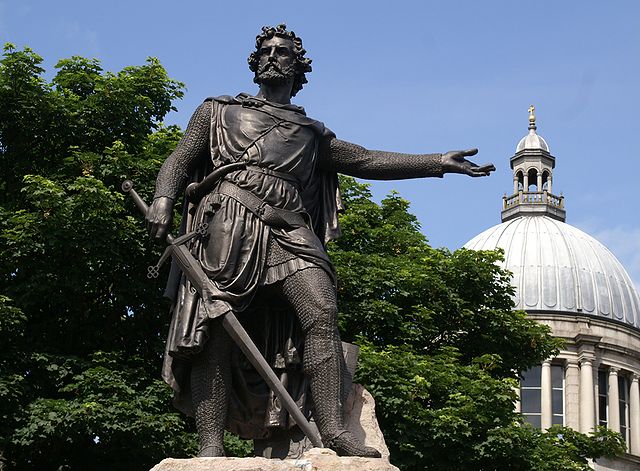*Image Credit: Wikimedia Commons For the better part of a decade, the English sought a near-mythical warrior from Scotland responsible for the deaths of countless administrators and soldiers. After finally capturing William Wallace, the Crown ensured he suffered a gruesome death on August 23, 1305. Known just as much for his brilliant tactics as his brute strength and relentless pursuit of a free Scotland, Wallace has been a popular figure in legend and fiction ever since. Very little is known of the man in his early days. Wallace likely had two older brothers and clearly descended from someone in the Scottish nobility. Historians point to Elderslie, Renfrewshire as his birthplace, though some have recently claimed Ellerslie in Ayrshire to be the correct location. His family tree has roots in both towns, but because there are no writings from the time suggesting an exact village or date of birth, the truth may never be known. Problems arose in Scotland upon the death of King Alexander III in 1286 after a fall from his horse. His granddaughter Margaret, a young girl and his only remaining heir, lived in Norway and had to travel by ship to claim her inheritance and new title as Queen of Scots. Along the way, she became sick, succumbing to the illness before taking her seat and leaving the kingdom without a monarch. Disputes erupted among the nobility as to who had rightful claim to the crown. In attempt to avoid war, the Scottish landowners invited King Edward of England to help them determine who should rise to the throne. Before he would decide, the king forced the attendants to swear an oath to him as Lord Paramount of Scotland, in effect making them to submit to him as the overarching ruler and pay annual taxes. He would rule John Balliol as king in 1292, then rescind much of Scottish law and drive Balliol to abdicate after defeating the rebellious Scot in 1296. Stung by Edward’s treachery and refusing to swear an oath to the English king, Wallace and other nobles set out to restore Scottish independence. Wallace began by assassinating the High Sheriff of Lanark in May 1297, then joined William the Hardy for a raid on Scone. Disorganized and using guerilla tactics, the Scots gathered together in early September to create a united force. The Battle of Stirling Bridge, won by a numerically inferior Scottish army against some 11,000 English soldiers, lifted the small rebellion to new heights. Bursting with confidence, the Scots pressed across the border into Northumberland and Cumberland by the end of the year. The tide turned in April 1298 when the English invaded Edinburgh. Soon after, Wallace suffered defeat at Falkirk and the rebellious Scots were now on the run. The enemy advanced further and further, attempting to bait Wallace into a frontal assault, but he could not be captured. Records of his whereabouts have been lost, though some believe he left for France in search of help from King Phillip IV before turning up again in 1304. Wallace survived in hiding, occasionally engaging in small attacks on the English, until John de Menteith turned him over to the Crown on August 5, 1305. Despite holding letters demanding his safety in case of capture from King Haco of Norway and King Phillip of France, Wallace faced the court for treason and murdering civilians, “sparing neither age nor sex, monk nor nun.” Asserting that he “could not be a traitor to Edward, for I was never his subject,” Wallace was found guilty on all counts. On August 23, 1305, having been dragged through the streets naked to Smithfield, Wallace met his end by the gruesome fate of being hanged, drawn and quartered. Afterwards, his head was displayed on a pike on London Bridge and his arms and legs shipped to four other cities as reminders of what awaited those who opposed the king.
August 23, 1305 CE – Scottish Hero William Wallace is Executed in London

